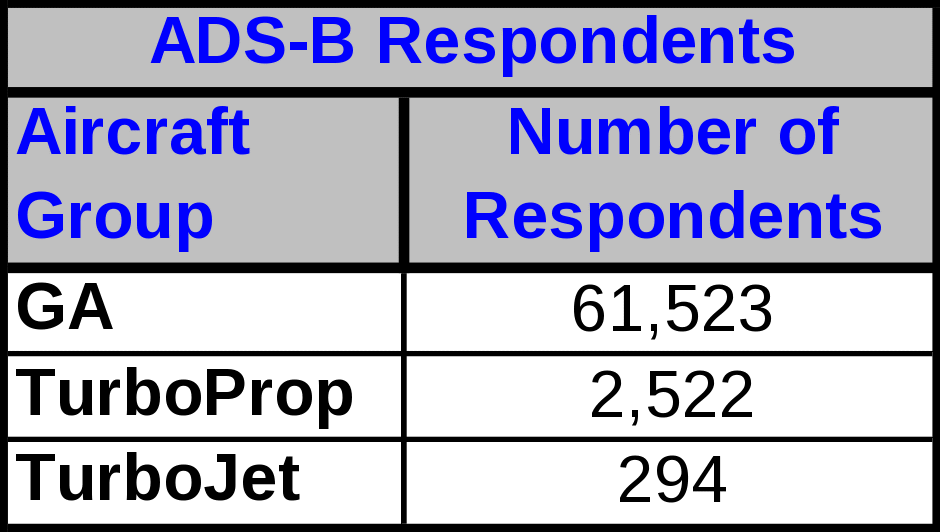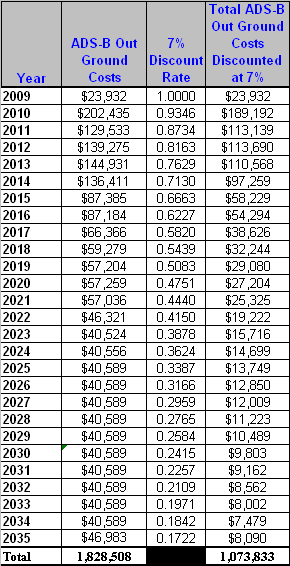2120-0728 2017
2120-0728 2017.doc
Automatic Dependent Surveillance Broadcast (ADS-B) Out Performance Requirements to Support Air Traffic Control (ATC) Service
OMB: 2120-0728
INFORMATION COLLECTION SUPPORTING STATEMENT
Automatic Dependent Surveillance – Broadcast (ADS-B) Out Performance Requirements to Support Air Traffic Control (ATC) Service
2120-0728
Explain the circumstances that make the collection of information necessary.
Title 49 of the United States Code, Subtitle VII, Aviation Programs, described in detail the scope of the agency’s authority. This rulemaking was promulgated under the authority described Subtitle VII, Part A, Subpart I, Section 40103, Sovereignty and use of the Airspace, and Subpart III, Section 44701, General requirements.
Under Section 40103, the FAA is charged with prescribing regulations on the flight of aircraft, including regulations on safe altitudes, navigating, protecting, and identifying aircraft, and the safe and efficient use of the navigable airspace. Under Section 44701, the FAA is charged with promoting safe flight of civil aircraft in air commerce by prescribing regulations for practices, methods and procedures the Administrator finds necessary for safety in air commerce.
This project is in direct support of the Department of Transportation’s Strategic Plan – Strategic Goal – CAPACITY; i.e., to increase capacity to meet projected demand and reduce congestion. Federal Regulations 14 CFR 91.225 and 14 CFR 91.227, dictates that effective January 1, 2020, aircraft operating in airspace defined in 91.225 are required to have an Automatic Dependent Surveillance – Broadcast (ADS-B) system that includes a certified position source capable of meeting requirements defined in 91.227.
Indicate how, by whom, and for what purpose the information is to be used.
14 CFR 91.225 and 14 CFR 91.227 supports the information needs of the FAA by requiring avionics equipment that continuously transmits aircraft information to be received by the FAA, via automation, for use in providing air traffic surveillance services.
Describe whether, and to what extent, the collection of information involves the use of automated, electronic, mechanical, or other technological collection techniques or other forms of information technology, e.g., permitting electronic submission of responses, and the basis for the decision for adopting this means of collection.
14 CFR 91.225 and 14 CFR 91.227 supports the Government Paperwork Elimination Act (GPEA). One hundred percent (100%) involves electronic collection of broadcast information from an aircraft to an automated receiver on the ground.
Describe efforts to identify duplication.
We have reviewed other FAA public-use reports and find no duplication. Also, the FAA knows of no other agency collecting the same information. The information sought is specific to aircraft being operated in the NAS. The information is available from that aircraft only, not from any other source.
If the collection of information has a significant impact on a substantial number of small businesses or other small entities.
The FAA has determined that a substantial number of small entities will be significantly affected and minimized the burden by considering the following alternatives:
Alternative One
The status quo alternative has compliance costs to continue the operation and commissioning of radar sites. The FAA rejected this status quo alternative because it is becoming operationally obsolete to use ground-based radars to track congested airways and pass information among control centers for the duration of flights. The current system is not able to upgrade to the NextGen capabilities, nor accommodate the estimated increases in air traffic, which would result in mounting delays or limitations in service for many areas.
Alternative Two
Alternative Two would employ a technology called multilateration. Multilateration is a separate type of secondary surveillance system that is not radar-based and has limited deployment in the U.S. At a minimum, multilateration requires at least four ground stations to deliver the same volume of coverage and integrity of information as ADS–B, because of the need to "triangulate" the aircraft's position.
Multilateration is a process that determines aircraft position by using the difference in time of arrival of a signal from an aircraft at a series of receivers on the ground. Multilateration meets the need for accurate surveillance and is less costly than ADS–B (however, more costly than radar), but cannot achieve the same level of benefits as ADS–B, such as system capacity and environmental improvements. Multilateration would provide the same benefits as radar, but the FAA estimates that the cost of providing multilateration (including the cost to sustain radar until multilateration is operational), would exceed the cost to continue full radar surveillance.
Alternative Three
Alternative Three would provide relief by having the FAA provide an exemption to small air carriers from all requirements of this rule. This alternative would mean that small air carriers would rely on the status quo ground-based radars to track their flights and pass information among control centers for the duration of the flights.
As discussed previously, ADS-B Out cannot be used effectively as the primary surveillance system if certain categories of airspace users are subject to separate surveillance systems. The small air carriers operate in the same airspace as the larger carriers and general aviation. Such an exemption would require two primary surveillance systems, which adds the cost of an additional surveillance system without improving the existing benefits. Thus, this alternative is not considered to be acceptable.
Alternative Four
Alternative Four exempts small-piston engine GA operators from the requirements of this final rule. This final rule provides minimal benefits to small-piston engine GA operators, while adding significant costs by mandating these operators to retrofit and equip about 150,000 small piston engine GA airplanes with ADS–B Out. Even though the FAA determined that the percentage of small piston engine GA airplanes operating at the top Operational Evolution Plan 35 airports is less than 5%, the number of GA operations within a 30-nautical-mile radius of these airports is significant. This alternative was not considered acceptable because ADS-B equipage for all aircraft operating in the airspace subject to this rule is essential to gaining the overall stated ADS-B benefits, realizing savings associated with radar decommissioning, and the expansion of potential future benefits.
Alternative Five
This alternative is the final ADS–B rule. ADS–B does not employ different classes of receiving equipment or provide different information based on its location. Therefore, controllers will not have to account for transitions between surveillance solutions as an aircraft moves closer to or farther away from an airport. To address congestion and delay, fuel consumption, emissions, and future demand for air travel without significant delays or denial of service, the FAA found ADS–B to be the most cost-effective solution to maintain a viable air transportation system. ADS–B provides a wider range of services to aircraft users and could enable applications that are not available with multilateration or radar.
Describe the consequence to Federal program or policy activities if the collection is not conducted or is conducted less frequently, as well as any technical or legal obstacles to reducing burden.
Without this information collection, the transition to the Next Generation Air Transportation System (NextGen), which will provide more efficient service for aircraft operating in the NAS and meet the growing demands on the air traffic control system, will not be possible. (See Question 5, discussion of Alternative 5.)
Explain any special circumstances that require the collection to be conducted in a manner inconsistent with the general information collection guidelines in 5 CFR 1320.5(d)(2).
Federal Regulations requires operators to equip aircraft operating in specified airspace within the NAS with ADS-B avionics that continually transmit aircraft information (in “real time”) to FAA ground receivers. The information is used for air traffic control surveillance of those operations.
Describe efforts to consult persons outside the agency to obtain their views on the availability of data, frequency of collection, the clarity of instructions and recordkeeping, disclosure, or reporting format (if any), and on the data elements to be recorded, disclosed, or reported.
A 60-day notice for public comments was published in the Federal Register on December 14, 2016 (81FR90408). No comments were received.
Explain any decision to provide any payment or gift to respondents, other than remuneration of contractors or grantees.
There are no monetary considerations for this collection of information.
Describe any assurance of confidentiality provided to respondents and the basis for the assurance in statute, regulation, or agency policy.
The respondents are not given assurance of confidentiality.
Provide additional justification for any questions of sensitive nature, such as sexual behavior and attitudes, religious beliefs, and other matters that are commonly considered private.
There are no questions of a sensitive nature.
Provide estimates of hour burden of the collection of information.
This information is collected electronically without input from the human operator.
The following table shows the number of respondents who have installed ADS-B Out equipment.

Provide an estimate of the total annual cost burden to respondents or recordkeepers resulting from the collection of information.
The following table shows the range of total costs for an ADS-B Out-compliant transponder. These costs include the sum of the unit, maintenance, installation and certification costs. These costs do not include the cost of upgrades for future navigational aides such as ADS-B In.

Provide estimates of annualized cost to the Federal Government.
The Federal government incurs costs to provide ADS-B surveillance uplink and downlink services, TIS-B and FIS-B services. Since these costs are incurred in order to provide data on aircraft they are all considered data collection costs.
Total government costs to provide these services are estimated at $1.8 billion over 27 years, or about $68 million per year. Total costs discounted by 7% are $1.1 billion as presented below. To annualize these costs over 27 years we multiply $1.074 billion by .08343 to derive $89.6 million annualized cost.

Explain the reasons for any program changes or adjustments reported in Items 13 or 14 of the OMB Form 83-I.
There are no burden changes from the previous submission.
For collections of information whose results will be published, outline plans for tabulation and publication.
There is no plan for tabulation or publication.
If seeking approval to not display the expiration date for OMB approval of the information collection, explain the reasons that display would be inappropriate.
No such approval is being sought.
Explain each exception to the certification statement identified in Item 19, “Certification for Paperwork Reduction Act Submissions,” of OMB Form 83-I.
There are no exceptions.
| File Type | application/msword |
| File Title | INFORMATION COLLECTION SUPPORTING STATEMENT |
| Author | Taylor CTR Dahl |
| Last Modified By | Thompson, Ronda (FAA) |
| File Modified | 2017-04-20 |
| File Created | 2017-04-20 |
© 2026 OMB.report | Privacy Policy